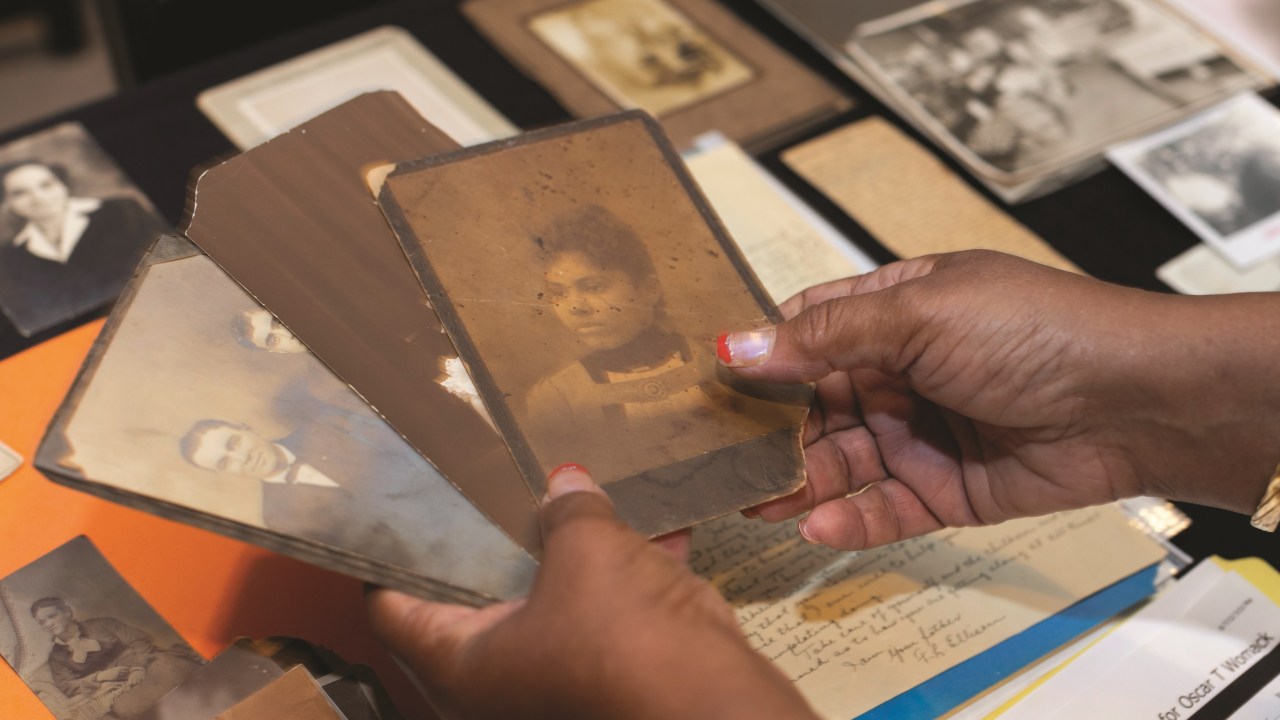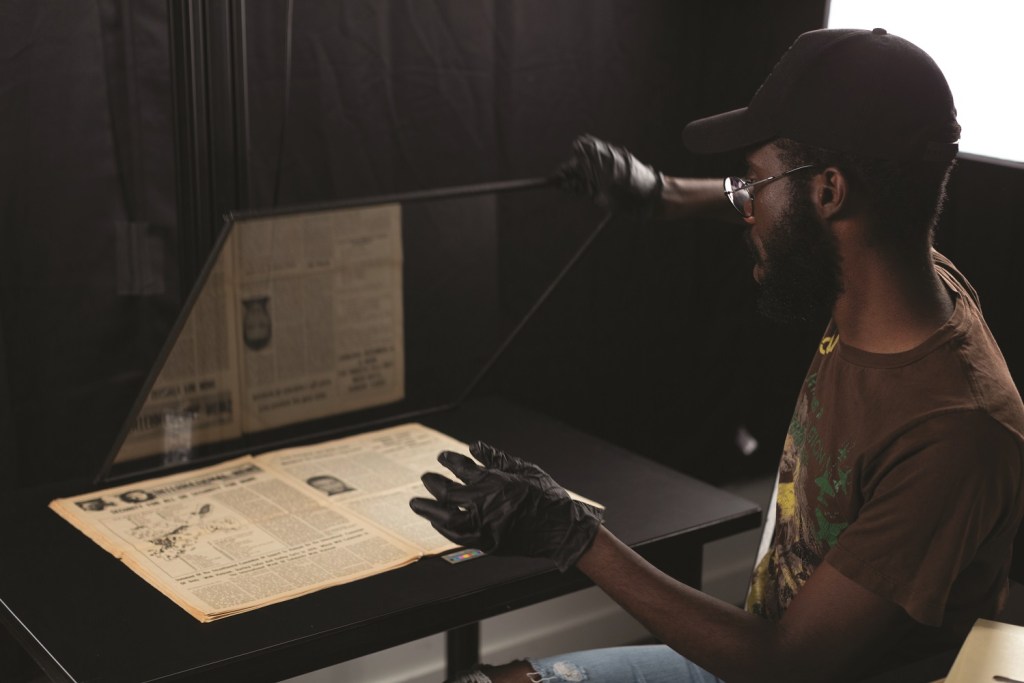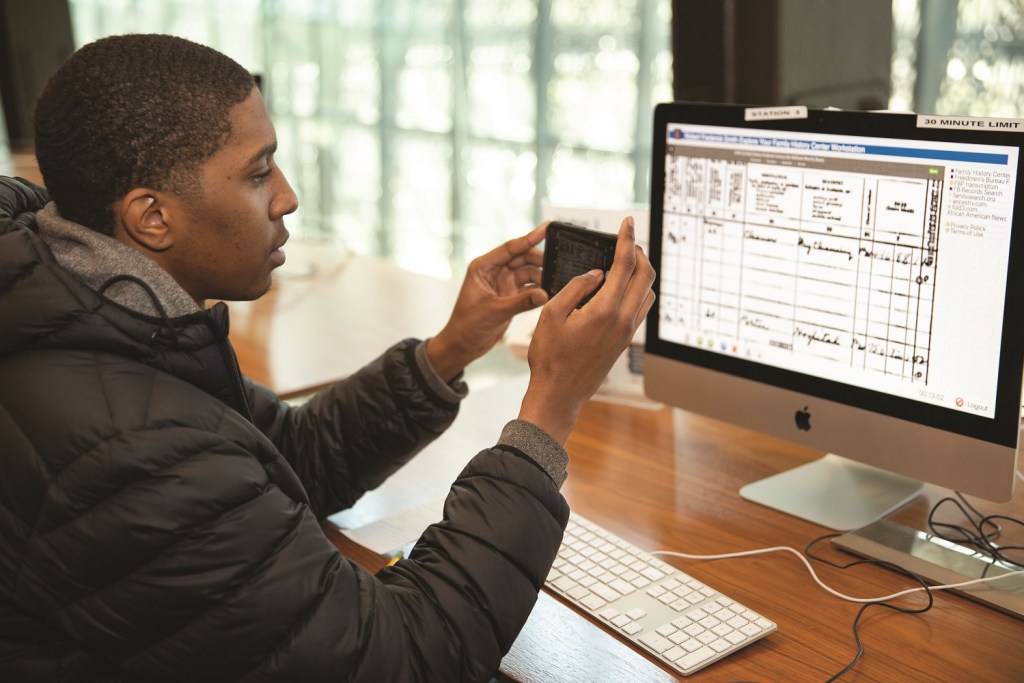
This article originally appeared in the May/June 2022 issue of Museum magazine, a benefit of AAM membership.
The Robert F. Smith Center for the Digitization and Curation of African American History is uncovering family stories and capturing community histories.
With heavy exhaustion, Mr. Gray gently set down the cloudy plastic tub filled with memories. He gathered the bins and boxes years ago after his parents had passed away and their house sold. When he heard about the Community Curation event at the Blair-Caldwell African American Research Library in Denver, he packed everything in his truck and made his way to the Five Points neighborhood.
He reached into the bin of pictures, certificates, and receipts and lifted out a fragile bundle of letters pressed together and bound tightly with twine. After patiently and painstakingly peeling one letter from the other, he gasped. Recognizing the gem he had found, he smiled and looked at us.
“I found my parents’ love letters. From the war!” he said. With a click of a camera shutter, another memory captured. We were all still and quiet, letting him absorb the moment.
Perfect penmanship graced the envelopes. With his permission, we quickly scanned the letters. The longing radiates from the page. She heavy-heartedly awaits his return.
Mr. Gray, now in his 70s, was engrossed in the conversations pressed into paper more than 60 years ago. I wondered if he was experiencing a piece of his parents’ lives he never encountered before. Were his mother’s descriptions of the rambunctious children accurate, humorous?
This is but one example of the Community Curation Program in action. Operated by the Robert F. Smith Center for the Digitization and Curation of African American History, the program seeks the voices that bring energy to historic places and paths, the joy found in generations of family stories, the aromas of that one dish prepared with the same vegetables and herbs for the past 100 years, an understanding of why and how neighborhoods emerged.
The Smith Center serves as the burgeoning digital humanities and public history forum for the National Museum of African American History and Culture (NMAAHC). Rooted in community collaboration, accessibility of collections and histories, continuing education, and genealogical support for institutional and community partners, the Smith Center is expanding NMAAHC’s reach.

Capturing Lives and Stories
Over the past four years, the Smith Center’s Community Curation Program (CCP) has brought NMAAHC’s digitization services to communities and institutions to capture the lives and stories of people representing all regions and walks of life, including those who may not have the opportunity to visit the museum.
The first sites selected for community curation were five cities with historic Black populations: Baltimore, Denver, Chicago, New York City, and St. Louis. So far, the community curation team has gone to Baltimore, Denver, and Chicago, but the Smith team has also collaborated with institutions and communities in the DC metropolitan area, including District of Columbia Archives and DC History, as well as the James Solomon Russell-Saint Paul’s College Museum and Archives, and the College of William and Mary. We’ve also worked with the Ashé Cultural Center in New Orleans and the Nicodemus National Park Service site in Kansas.
When we travel to cities for community curation, we partner with local cultural institutions. For example, in Denver, we collaborated with the Blair-Caldwell African American Research Library and the Black American West Museum. In Chicago, we partnered with the Black Metropolis Research Consortium, which included the DuSable Museum of African American History, Chicago State University, and Shorefront Legacy Center.
During a CCP event, the Smith team builds out space at partnering institutions for still and moving image digitization. Families and individuals arrive with their photographs, VHS tapes, genealogical documents, and 35 mm film for the team to digitize. All participants receive a USB drive with their digitized items and leave with all of their material.
One family in Chicago climbed aboard the Smith Center mobile digitization truck with boxes of film that showcased the joy and happiness at the Roberts Show Lounge, which once stood on the south side of the city. The elder Roberts had established the lounge, and the films captured the essence of the Chicago Black leisure scene in the 1960s, ’70s, and ’80s.
People often bring tattered and torn photographs, and the team is able to digitally restore the images. One woman arrived at Chicago’s DuSable Museum with her young daughter in tow. She handed a torn 19th-century photograph she described as her multi-great grandmother to our photography specialist. As she waited for the digitally repaired image, our genealogy reference assistant worked with her to determine who the stately woman in the photograph was. Once her digitally restored image was prepared, she marveled at the picture on the computer screen, turned to her little girl, and said, “This is your great-great-great-grandmother!” Beaming, mother and daughter left the museum with a greater sense of connection to the maternal figure in that photograph.
Going Virtual
The Smith team was just exiting New Orleans when the COVID-19 global pandemic postponed in-person community projects for almost two years. However, the Smith Center increased its reach when genealogy sessions and public programs went virtual during the pandemic.
During that time, the Smith Center used the Community Curation Platform, a dynamic digital resource on the NMAAHC website that invites African American families, civic organizations, and cultural institutions to share their histories with our museum community. The site was built in 2017 for use during our travel, but we’ve been able to use it to gather stories and share experiences while the museum was shuttered and our travel paused. Using their smartphones or desktop computers, participants follow online instructions to create accounts, upload their digital images, and share their experiences with the world.
As part of the “Voices of Resistance and Hope” story-sharing project on the Community Curation Platform, a woman posted her strongly worded letter from 1965 that rebuked the Aunt Jemima imagery used by the Pearl Milling Company. The response to her letter stated that the caricature rightly represented a historical memory of Black women in America. Over 50 years later, the Pearl Milling Company finally abandoned the racist and sexist imagery it had used for over a century to strategically diminish the intellectual and social power of Black women. The woman’s letter captured the history of the resistance to these hateful and harmful images.
Another virtual visitor uploaded his experience at the marches held on the National Mall after the brutal murder of George Floyd by Minneapolis police officers. He captured a generational fight for racial and social justice, a fight he pledged to maintain. And another participant submitted her family’s determination to celebrate the elders in her family even while they needed to remain distant due to the deadly virus.
Service to Institutions
In its partnerships with and travel to other museums and cultural institutions, the Smith Center team has recognized a dire lack of up-to-date preservation equipment and affordable, accessible, and secure digital storage. Since the team cannot physically visit each community in need of our preservation and digitization services, the Smith Center will begin supplying selected partners with digitization equipment.
Even before the pandemic, it was clear to the team that supporting institutions and communities by providing technical training and gifting equipment for digitization would be the best use of Smith Center funding. The Smith Center will also purchase cloud storage so that all institutions can host their newly digitized collections. In the end, the triad of equipment, digital space, and training nurtures sustainable professional relationships and creates self-sufficient institutions.
The team also ascertained that in addition to needing equipment and digital storage, partners and communities wanted more training and workshops in order to conduct their own projects. In 2021, the team began implementing Community Archiving Workshops, or CAWs. Offered free of charge, CAWs are perfect for institutions and communities without proper inventories or finding aids for their collections. The workshops bring together community members, advocates, professionals in the field, and institutional leadership to facilitate archiving and encourage collaboration. The workshops also provide digitization stations, equipment tutorials, and media-defining exploration and training.
The Smith Center recently conducted a CAW for the John Solomon Russell-Saint Paul’s College Museum and Archives in rural Brunswick County, Virginia, which was struggling to preserve material and capture its unique history. This project united NMAAHC’s efforts to engage HBCUs, the Smithsonian’s desire to connect with rural communities, and the Smith Center’s goal of digitally preserving endangered collections. In turn, NMAAHC can use this information to enhance its own telling of African American experiences in exhibitions, programs, and outreach.

The Roads, Places, and Spaces Ahead
The Smith Center programs now must use what has been preserved and digitized to answer questions that interrogate digital divides, critically expose invisibility, reproach unequal power relations, and uncover hidden historical narratives. We must use these collections to look critically at historical and cultural movements and offer explanations of the current realities of race, gender, class, and sexuality.
How do we use what is collected through this work to take the lead in shifting the historical lens of American history toward recognizing the multiple narratives of Black life? How do we use what we have collected to reimagine cultural tourism and visitor bureaus? How do we center genealogy and local histories to inform larger historical narratives? How do we understand genealogy through the lens of digital humanities? In what ways do we use this digital material to create curriculum for students at every educational level?
Nearly two years after our last project in New Orleans was postponed due to the pandemic, our team is back on the road. We are revisiting communities, including New Orleans, and collaborating and partnering with new people and institutions, such as Xavier and Dillard universities, two historically Black college and universities; the Ashé Cultural Arts Center; and the Amistad Research Center. The impact of the pandemic on families, communities, and institutions has heightened the importance of gathering stories and preserving local histories.
The true assessment of the Smith Center is not solely the numbers of people, communities, or institutions that participate in our programming; it also lies in the enriched connections we make among the museum and visitors, collaborators, and learners. Now more than ever, we must capture the forever-changed landscape of life, memory, history, and family.
Doretha K. Williams is director of the Robert F. Smith Center for the Digitization and Curation of the African American History at the National Museum of African American History and Culture in Washington, DC.
Other Smith Center Programs
In addition to the Community Curation Program, the Smith Center operates the Family History Center and the Internship and Fellowship Program. All three programs aim to broaden the audience base of the National Museum of African American History and Culture (NMAAHC), preserve local histories, and provide the next generation of cultural institution leaders.
The Family History Center (FHC), on-site at NMAAHC, guides visitors through genealogy research sessions. Visitors both on-site and online can sign up for research sessions led by genealogy reference assistants. Prior to the pandemic, on-site participants could use a bank of computers and databases, including Family Search, Fold3.com, and Ancestry.com, to conduct their research. Often, visitors attend sessions with birthdates and names and leave with a better understanding of their family history. By managing the FHC and providing guided family history research support, the Smith team can nurture deeper and more intimate connections with visitors.
Through the summer Internship and Fellowship Program, the Smith Center is diversifying the museum field with Black and brown voices, experiences, and expertise. Interested museums, archives, and cultural centers submit proposals that outline digital humanities internship projects that have ranged from digitization of oral history recordings and photograph collections to creating searchable digital platforms and augmented reality projects. Participating institutions select their interns through the application portal, and the Smith Center provides stipends and housing support for the interns throughout the summer.
The Internship and Fellowship Program has partnered with historically Black colleges and universities, including Tuskegee, Bethune-Cookman, Morgan State, and Fisk universities, to provide them with interns with experience in the digital humanities and museum management. The program has also placed interns with cultural institutions, including Maine Historical Society, Historic Stagville in North Carolina, and the Amistad Research Center in New Orleans. NMAAHC also serves as a site for interns, and the museum has hired three interns as full-time staff to date.
Resources
Smith Center
nmaahc.si.edu/explore/museum-centers/center-digitization-and-curation-african-american-history
Community Curation Platform
communitycuration.org/home/defaultLanding
Family History Center
nmaahc.si.edu/explore/museum-centers/digitization-curation-african-american-history/family-history







